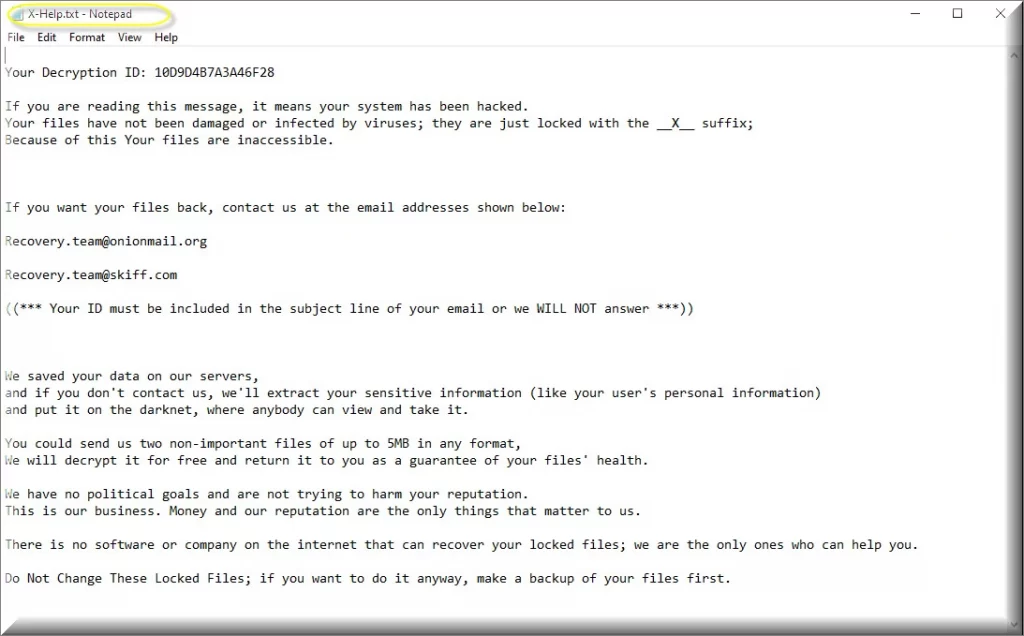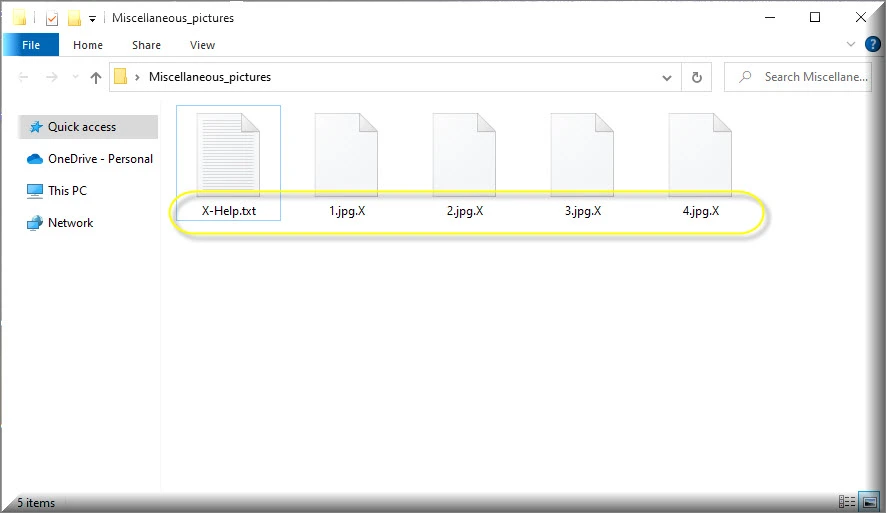X Ransomware
X Ransomware belongs to arguably the most dangerous category of malicious code – ransomware. What’s more, this is actually a file-encrypting ransomware variant, similar to Popn or Pouu. And this makes X Ransomware one of the worst types of malware you may come across. File-encrypting ransomware ends up costing its victims millions upon millions of dollars each year. And the reason isn’t necessarily because of the obscene amounts of money that the hackers demand in ransom. Usually it’s because of the devastating data loss that individuals and organizations end up suffering as a result of attacks like this. In truth, one of the main contributors to ransomware’s notorious danger level is the fact that no one can guarantee what will become of your files once they’ve been encrypted.

The encryption used by variants such as X Ransomware is incredibly strong, and it renders the affected files unreadable and inaccessible. And the cybercriminals behind the virus will have you believe that the only possible way you can regain access to your valuable information is if you pay them for a special decryption key.
However, while that is certainly a viable option, receiving the said decryption key won’t necessarily promise that you will indeed be able to use your files again. There are many things that could go amiss, and we won’t waste your time in trying to describe it all. But the good news is that there are also alternative methods that you can try before resorting to the ransom payment.
First and foremost, however, it is vital that you remove X Ransomware from your computer before attempting any file-recovery solutions, whatever those may be. And we can show you how to do this with the help of the removal guide below.
The X Ransomware virus
The X Ransomware virus is highly dangerous as it normally acts in complete stealth and without the display of any symptoms. This allows the X Ransomware virus to finish its dirty business undisturbed, right under the noses of its victims. What adds fuel to this proverbial fire is that fact that most antivirus software isn’t equipped to detect ransomware variants while they’re at work. And this is because the encryption process itself is not malicious and, therefore, in this instance it’s not deemed a threat by your antivirus software. On the bright side, though, the encryption process usually takes a significant time to complete, depending of course on factors like the amount of data stored on the infected PC and its processing power.

Hence, if there’s a lot of files and not that much processing power, then the computer may experience a significant slowdown, which may prompt a proactive enough user to have a look at the Task Manager and see what the issue is. The ransomware virus should be visible there as the process consuming the most RAM and CPU.
The X Ransomware file extension
The The X Ransomware file extension is a unique identifier of this virus, and it is added to each encrypted file. This approach disrupts the normal data structure, essentially cloaking the files from recognition by standard software applications. By substituting the regular file format, the X Ransomware extension signals the successful encryption of your files and the onset of a ransom demand. As a victim, spotting this extension on your files is an alarming red flag indicating your data’s unreadability. It’s crucial to act promptly upon noticing the X Ransomware file extension to mitigate potential data loss, emphasizing the importance of having robust cyber hygiene practices to prevent such ransomware invasions.
SUMMARY:
| Name | X Ransomware |
| Type | Ransomware |
| Danger Level | High (Ransomware is by far the worst threat you can encounter) |
| Symptoms | Very few and unnoticeable ones before the ransom notification comes up. |
| Distribution Method | From fake ads and fake system requests to spam emails and contagious web pages. |
| Data Recovery Tool | Not available |
| Detection Tool |
Some threats reinstall themselves if you don’t delete their core files. We recommend downloading SpyHunter to remove harmful programs for you. This may save you hours and ensure you don’t harm your system by deleting the wrong files. |
Remove X Ransomware

Some of the steps will likely require you to exit the page. Bookmark it for later reference.
Reboot in Safe Mode (use this guide if you don’t know how to do it).

WARNING! READ CAREFULLY BEFORE PROCEEDING!
Press CTRL + SHIFT + ESC at the same time and go to the Processes Tab. Try to determine which processes are dangerous.

Right click on each of them and select Open File Location. Then scan the files with our free online virus scanner:

After you open their folder, end the processes that are infected, then delete their folders.
Note: If you are sure something is part of the infection – delete it, even if the scanner doesn’t flag it. No anti-virus program can detect all infections.

Hold the Start Key and R – copy + paste the following and click OK:
notepad %windir%/system32/Drivers/etc/hosts
A new file will open. If you are hacked, there will be a bunch of other IPs connected to you at the bottom. Look at the image below:

If there are suspicious IPs below “Localhost” – write to us in the comments.
Type msconfig in the search field and hit enter. A window will pop-up:

Go in Startup —> Uncheck entries that have “Unknown” as Manufacturer.
- Please note that ransomware may even include a fake Manufacturer name to its process. Make sure you check out every process here is legitimate.

Type Regedit in the windows search field and press Enter. Once inside, press CTRL and F together and type the virus’s Name.
Search for the ransomware in your registries and delete the entries. Be extremely careful – you can damage your system if you delete entries not related to the ransomware.
Type each of the following in the Windows Search Field:
- %AppData%
- %LocalAppData%
- %ProgramData%
- %WinDir%
- %Temp%
Delete everything in Temp. The rest just check out for anything recently added. Remember to leave us a comment if you run into any trouble!

How to Decrypt X Ransomware files
We have a comprehensive (and daily updated) guide on how to decrypt your files. Check it out here.
If the guide doesn’t help, download the anti-virus program we recommended or try our free online virus scanner. Also, you can always ask us in the comments for help!

Leave a Reply